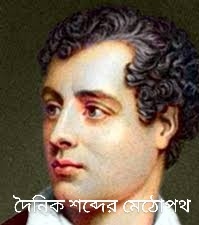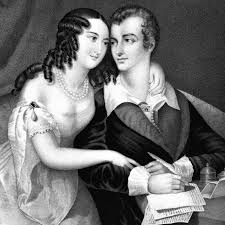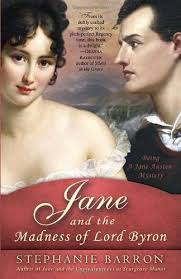জর্জ গর্ডন বায়রন
Lord Byron, was an English poet and peer.] One of the leading figures of the Romantic movement,[3][4][5] Byron is regarded as one of the greatest English poets.[6] He remains widely read and influential. Among his best-known works are the lengthy narrative poems Don Juan and Childe Harold's Pilgrimage; many of his shorter lyrics in Hebrew Melodies also became popular.
জন্ম : 22 জানুয়ারী 1788 তারিখ। লন্ডনের হোলস স্ট্রিট। তাঁর জন্মস্থানটি এখন ডিপার্টমেন্ট স্টোর জন লুইসের একটি শাখা দ্বারা দখল করা হয়েছে।
বায়রন ছিলেন ক্যাপ্টেন জন বায়রন ('জ্যাক' নামে পরিচিত) এবং তার দ্বিতীয় স্ত্রী ক্যাথরিন গর্ডনের একমাত্র সন্তান, স্কটল্যান্ডের অ্যাবারডিনশায়ারে গাইট এস্টেটের উত্তরাধিকারী।
বায়রনের পিতামহ ছিলেন ভাইস-এডমিরাল জন বায়রন এবং সোফিয়া ট্রেভানিয়ন।
একজন কিশোর মিডশিপম্যান হিসাবে একটি জাহাজডুবি থেকে বেঁচে থাকার পরে, ভাইস অ্যাডমিরাল জন বায়রন বিশ্বকে প্রদক্ষিণ করার জন্য একটি নতুন গতির রেকর্ড স্থাপন করেছিলেন।
আমেরিকান বিপ্লবী যুদ্ধের সময় তিনি একটি তুমুল সমুদ্রযাত্রায় জড়িয়ে পড়ার পর, প্রেস দ্বারা জনকে 'ফাউল-ওয়েদার জ্যাক' বায়রন নামে ডাকা হয়।
বায়রনের বাবা ইতিপূর্বে কারমার্থেনের মার্চিয়নেস অ্যামেলিয়াকে কিছুটা কলঙ্কজনকভাবে বিয়ে করেছিলেন, যার সাথে তার সম্পর্ক ছিল – তার স্বামীর কাছ থেকে বিবাহ বিচ্ছেদের কয়েক সপ্তাহ পরে বিয়ে হয়েছিল এবং তিনি প্রায় আট মাসের গর্ভবতী ছিলেন।
বিবাহটি সুখী ছিল না, এবং তাদের প্রথম দুই সন্তান - সোফিয়া জর্জিনা এবং একটি নামহীন ছেলে - শৈশবেই মারা যায়।
1784 সালে তাদের তৃতীয় সন্তান, কবির সৎ বোন অগাস্টা জন্মের ঠিক এক বছর পর অ্যামেলিয়া নিজেই মারা যান.
জ্যাক তারপর 13 মে 1785 তারিখে ক্যাথরিন গর্ডন অফ গাইটকে বিয়ে করেন, শুধুমাত্র তার ভাগ্যের জন্য।
স্কটল্যান্ডে তার দ্বিতীয় স্ত্রীর সম্পত্তি দাবি করার জন্য, বায়রনের বাবা অতিরিক্ত উপাধি "গর্ডন" নিয়েছিলেন, "জন বায়রন গর্ডন" হয়ে ওঠেন এবং মাঝে মাঝে নিজেকে "জন বায়রন গর্ডন অফ গাইট" স্টাইল করেন।
বায়রনের মাকে তার নতুন স্বামীর ঋণ পরিশোধের জন্য তার জমি এবং শিরোনাম বিক্রি করতে হয়েছিল, এবং দুই বছরের ব্যবধানে, প্রায় 23,500 পাউন্ড মূল্যের বিশাল সম্পত্তিটি নষ্ট হয়ে গিয়েছিল, প্রাক্তন উত্তরাধিকারীর বার্ষিক আয়ের ভরসা মাত্র £ 150।
তার পাওনাদারদের এড়াতে একটি পদক্ষেপে, ক্যাথরিন 1786 সালে তার প্রতারক স্বামীর সাথে ফ্রান্সে যান, কিন্তু 1787 সালের শেষের দিকে তার ছেলের জন্ম দেওয়ার জন্য ইংল্যান্ডে ফিরে আসেন।
ছেলেটির জন্ম 22 জানুয়ারী লন্ডনের হোলস স্ট্রিটের বাসস্থানে এবং সেন্ট মেরিলেবোন প্যারিশ চার্চে "জর্জ গর্ডন বায়রন" নামে নামকরণ করা হয়েছিল।
তার বাবা তার ছেলেকে 'উইলিয়াম' বলে ডাকতে চেয়েছিলেন বলে মনে হয়, কিন্তু তার স্বামী অনুপস্থিত থাকায় তার মা তার নাম তার নিজের পিতা জর্জ গর্ডন অফ গাইটের নামে রেখেছিলেন, যিনি স্কটল্যান্ডের জেমস -এর বংশধর ছিলেন এবং মারা যান। 1779 সালে আত্মহত্যা।
ক্যাথরিন 1790 সালে অ্যাবারডিনশায়ারে ফিরে আসেন, যেখানে বায়রন তার শৈশব কাটিয়েছিলেন। তার বাবা শীঘ্রই তাদের সাথে কুইন স্ট্রিটে তাদের বাসস্থানে যোগ দেন, কিন্তু দম্পতি দ্রুত আলাদা হয়ে যায়।
ক্যাথরিন নিয়মিত মেজাজের পরিবর্তন এবং বিষণ্ণতার সম্মুখীন হন, যা আংশিকভাবে তার স্বামীর কাছ থেকে ক্রমাগত অর্থ ধার করার দ্বারা ব্যাখ্যা করা যেতে পারে।
ফলস্বরূপ, তিনি তার দাবি সমর্থন করার জন্য আরও বেশি ঋণে পড়ে যান।
এটি এই অপ্রয়োজনীয় ঋণগুলির মধ্যে একটি ছিল যা তাকে ভ্যালেন্সিয়েনেস, ফ্রান্সে ভ্রমণ করতে দেয়, যেখানে তিনি 1791 সালে একটি "দীর্ঘ ও ভুগছেন অসুস্থতা" - সম্ভবত যক্ষ্মা রোগে মারা যান।
বায়রনের বড়-চাচা, যাকে মরণোত্তরভাবে "দুষ্ট" লর্ড বায়রন হিসেবে লেবেল করা হয়েছিল, 1798 সালের 21 মে মারা গেলে, 10 বছর বয়সী ছেলেটি রচডেলের ষষ্ঠ ব্যারন বায়রন হয়ে ওঠেন এবং নটিংহ্যামশায়ারে পৈতৃক বাড়ি নিউস্টেড অ্যাবে উত্তরাধিকার সূত্রে পেয়েছিলেন।
তাঁর মা গর্বিতভাবে তাকে ইংল্যান্ডে নিয়ে যান, কিন্তু অ্যাবে একটি বিব্রতকর অবস্থায় ছিল এবং সেখানে বসবাস করার পরিবর্তে, তিনি বায়রনের বয়ঃসন্ধিকালে এটিকে লর্ড গ্রে ডি রুথিনের কাছে ইজারা দেওয়ার সিদ্ধান্ত নেন।
"বিচার বা স্ব-আজ্ঞা ছাড়াই একজন মহিলা" হিসাবে বর্ণনা করা হয়েছে, ক্যাথরিন হয় তার ছেলেকে লুণ্ঠন ও প্ররোচিত করেছিলেন বা তার কৌতুকপূর্ণ জেদ দিয়ে তাকে বিরক্ত করেছিলেন।
তার মদ্যপান.বায়রন অ্যাবারডিন গ্রামার স্কুলে তার প্রাথমিক শিক্ষা লাভ করেন এবং 1799 সালের আগস্টে ডুলউইচের ড. উইলিয়াম গ্লেনির স্কুলে প্রবেশ করেন।
একজন ডাঃ বেইলির তত্ত্বাবধানে রাখা হয়েছিল, তাকে পরিমিত ব্যায়াম করতে উত্সাহিত করা হয়েছিল কিন্তু তার বিকৃত পায়ের জন্য অতিরিক্ত ক্ষতিপূরণ দেওয়ার প্রয়াসে "হিংসাত্মক" লড়াই থেকে নিজেকে সংযত করতে পারেনি।
তার মা তার পড়াশোনায় হস্তক্ষেপ করতেন, প্রায়ই তাকে স্কুল থেকে প্রত্যাহার করতেন, ফলে তার শৃঙ্খলার অভাব ছিল এবং তার শাস্ত্রীয় পড়াশোনা উপেক্ষিত ছিল।
1801 সালে, তাকে হ্যারোতে পাঠানো হয়, যেখানে তিনি 1805 সালের জুলাই পর্যন্ত ছিলেন।
একজন বিশিষ্ট ছাত্র এবং একজন অদক্ষ ক্রিকেটার, তিনি 1805 সালে লর্ডস-এ প্রথম ইটন বনাম হ্যারো ক্রিকেট ম্যাচের সময় স্কুলের প্রতিনিধিত্ব করেছিলেন।
তাঁর সংযমের অভাব শারীরিক ব্যায়ামের মধ্যে সীমাবদ্ধ ছিল না।
বায়রন মেরি চাওয়ার্থের প্রেমে পড়েছিলেন, যার সাথে তার স্কুলে দেখা হয়েছিল,
প্রেম, আমার মতে সব রোগের মধ্যে সবচেয়ে খারাপ। সংক্ষেপে, ছেলেটি মিস চাওয়ার্থের প্রেমে বিভ্রান্ত।"
Children :
Ada Lovelace
Allegra Byron
Elizabeth Medora Leigh (presumably)
Works :
Major works:
- Hours of Idleness (1807)
- Lachin y Gair (1807)
- English Bards and Scotch Reviewers (1809)
- Childe Harold's Pilgrimage, Cantos I & II (1812)
- The Giaour (1813) (text on Wikisource)
- The Bride of Abydos (1813)
- The Corsair (1814) (text on Wikisource)
- Lara, A Tale (1814) (text on Wikisource)
- Hebrew Melodies (1815)
- The Siege of Corinth (1816) (text on Wikisource)
- Parisina (1816) (text on Wikisource)
- The Prisoner of Chillon (1816) (text on Wikisource)
- The Dream (1816) (text on Wikisource)
- Prometheus (1816) (text on Wikisource)
- Darkness (1816) (text on Wikisource)
- Manfred (1817) (text on Wikisource)
- The Lament of Tasso (1817)
- Beppo (1818) (text on Wikisource)
- Childe Harold's Pilgrimage (1818) (text on Wikisource)
- Don Juan (1819–1824; incomplete on Byron's death in 1824) (text on Wikisource)
- Mazeppa (1819)
- The Prophecy of Dante (1819)
- Marino Faliero (1820)
- Sardanapalus (1821)
- The Two Foscari (1821)
- Cain (1821)
- The Vision of Judgment (1821)
- Heaven and Earth (1821)
- Werner (1822)
- The Age of Bronze (1823)
- The Island (1823) (text on Wikisource)
- The Deformed Transformed (1824)
- Letters and journals, vol. 1 (1830)
- Letters and journals, vol. 2 (1830)
Selected shorter lyric poems :
- Maid of Athens, ere we part (1810) (text on Wikisource)
- And thou art dead (1812) (text on Wikisource)
- She Walks in Beauty (1814) (text on Wikisource)
- My Soul is Dark (1815) (text on Wikisource)
- The Destruction of Sennacherib (1815) (text on Wikisource)
- Monody on the Death of the Right Hon. R. B. Sheridan (1816) (text on Wikisource)
- Fare Thee Well (1816) (text on Wikisource)
- So, we'll go no more a roving (1817) (text on Wikisource)
- When We Two Parted (1817) (text on Wikisource)
- Ode on Venice(1819) (text on Wikisource)
- Stanzas (1819)
- Don Leon (not by Lord Byron, but attributed to him; 1830s)
Byron wrote prolifically In 1832 his publisher, John Murray, released the complete works in 14 duodecimo volumes, including a life by Thomas Moore. Subsequent editions were released in 17 volumes, first published a year later, in 1833. An extensive collection of his works, including early editions and annotated manuscripts, is held within the John Murray Archive at the National Library of Scotland in Edinburgh.
Don Juan
Main article: Don Juan (poem)
Byron's magnum opus, Don Juan, a poem spanning 17 cantos, ranks as one of the most important long poems published in England since John Milton's Paradise Lost.[154] Byron published the first two cantos anonymously in 1819 after disputes with his regular publisher over the shocking nature of the poetry. By this time, he had been a famous poet for seven years, and when he self-published the beginning cantos, they were well received in some quarters. The poem was then released volume by volume through his regular publishing house.[44] By 1822, cautious acceptance by the public had turned to outrage, and Byron's publisher refused to continue to publish the work. In Canto III of Don Juan, Byron expresses his detestation for poets such as William Wordsworth and Samuel Taylor Coleridge.[44][155] In letters to Francis Hodgson, Byron referred to Wordsworth as "Turdsworth".[156]
Irish Avatar
Main article: Irish Avatar
Byron wrote the satirical pamphlet Irish Avatar after the royal visit by King George IV to Ireland. Byron criticised the attitudes displayed by the Irish people towards the Crown, an institution he perceived as oppressing them, and was dismayed by the positive reception George IV received during his visit. In the pamphlet, Byron lambasted Irish unionists and voiced muted support towards nationalistic sentiments in Ireland.
Signature
Died : 19 April 1824 (aged 36)
Missolonghi, Aetolia, Ottoman Empire (present-day Aetolia-Acarnania, Greece)
Resting place : Church of St. Mary Magdalene, Hucknall, Nottinghamshire।
=={============={{{{{{{∆∆∆∆∆∆}}}}}}}}}=










No comments:
Post a Comment